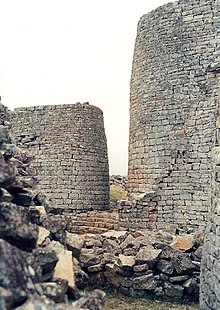Kingdom of Zimbabwe
From Wikipedia, the free encyclopedia
This article is about the pre-colonial African kingdom. For the modern-day Republic of Zimbabwe, see Zimbabwe.
| Kingdom of Zimbabwe | |||||
| Zimbabwe | |||||
| |||||
 Zimbabwe Bird | |||||
| Capital | Great Zimbabwe | ||||
| Religion | Belief in Mwari | ||||
| Government | Monarchy | ||||
| Mambo | Rusvingo (first) | ||||
| Unknown (last) | |||||
| History | |||||
| • | Abandonment of Mapungubwe for Zimbabwe | 1220 | |||
| • | Zimbabwe conquest of Mutapa | 1430 | |||
| • | Abandonment of Zimbabwe for Mutapa | 1450 | |||
Contents
[hide]Name[edit]
Main article: Name of Zimbabwe
Zimbabwe is the modern name issued to the most prominent pre-colonial civilization in southern Africa. The name is derived from one of two possible terms: the Shona (dzimba dza mabwe or "great stone houses") or Kalanga (Nzi we mabwe or "Homestead of Stone").Origin[edit]
Although the Kingdom of Zimbabwe was formerly established during the medieval period, archaeological excavations in the region suggest that state formation here was considerably more ancient. In 1901, south of the Zambezi in the northwestern Shona (Makalanga) area, a ceramic ushabti was exhumed and presented to Carl Peters. According to Flinders Petrie, who subsequently examined the mortuary figurine, it had a cartouche on its chest that belonged to the 18th Dynasty Egyptian Pharaoh Thutmose III. In Petrie's estimation, this royal inscription and other regalia on the artefact confirmed that the object was a genuine ancient statuette of the king himself. The ushabti's burial further appeared to represent proof of commercial ties between rulers in the area and the ancient Egyptians during the New Kingdom (c. 1550 BC–1077 BC), if not a relic of an old Egyptian station near the local gold mines.[1] Johann Heinrich Schäfer later appraised the statuette, and argued that it belonged to a well-known group of forgeries. After having received the ushabti, Felix von Luschan suggested that it was of more recent origin than the New Kingdom. He asserted that the figurine instead appeared to date to the subsequent Ptolemaic era (c. 323 BC–30 BC), when Alexandria-based Greek merchants would import Egyptian antiquities and pseudo-antiquities into southern Africa.[2]In the early 11th century, people from the Kingdom of Mapungubwe in Southern Africa are believed to have settled on the Zimbabwe plateau. There, they would establish the Kingdom of Zimbabwe (c. 1220).

No comments:
Post a Comment